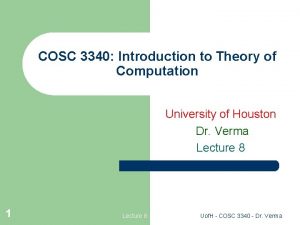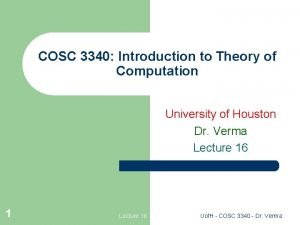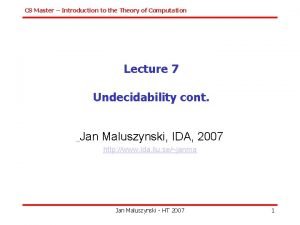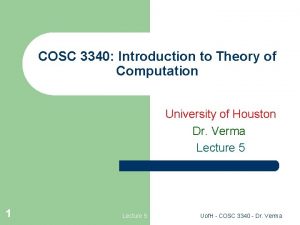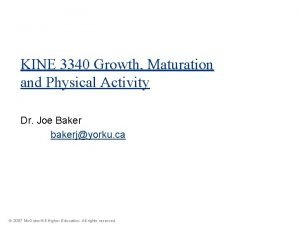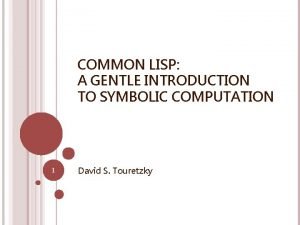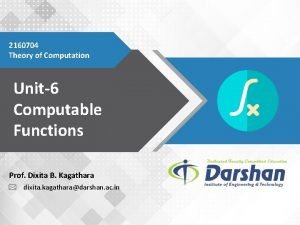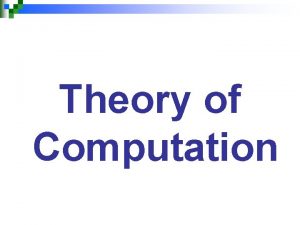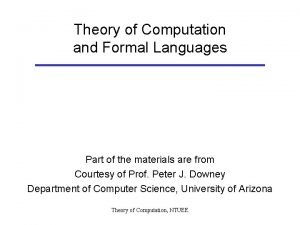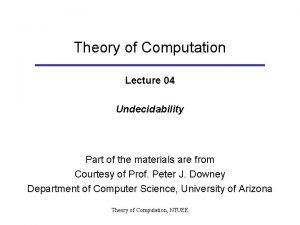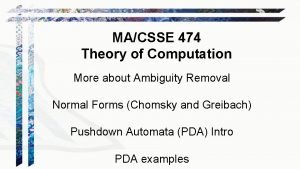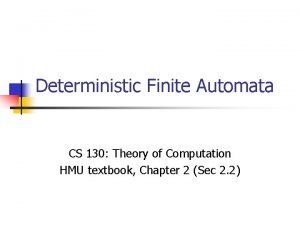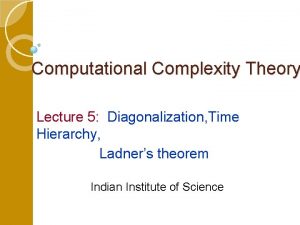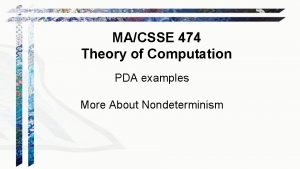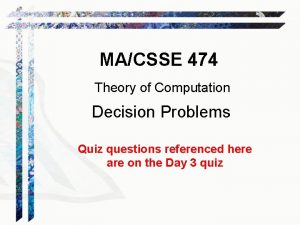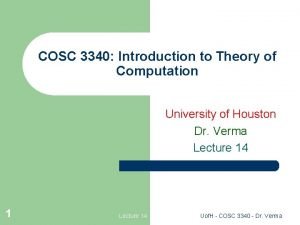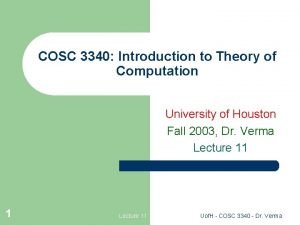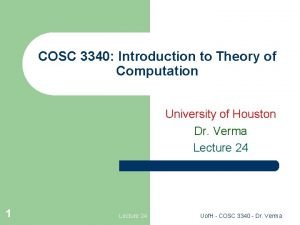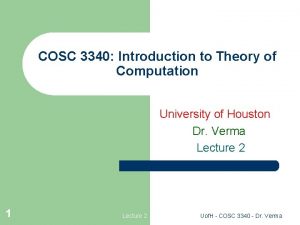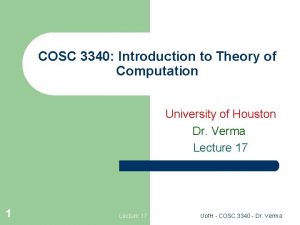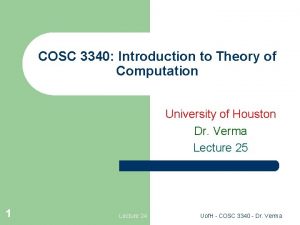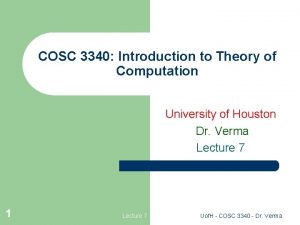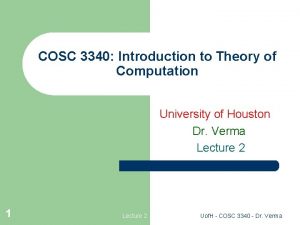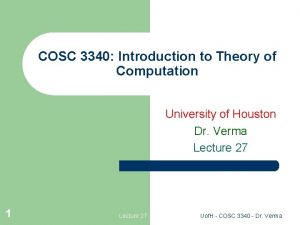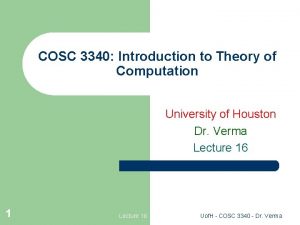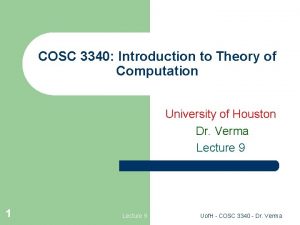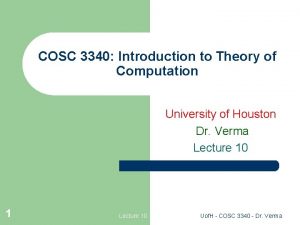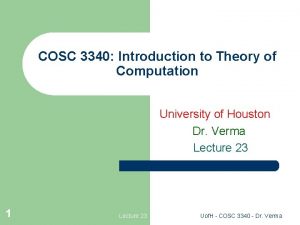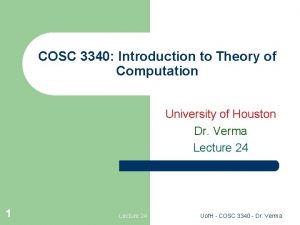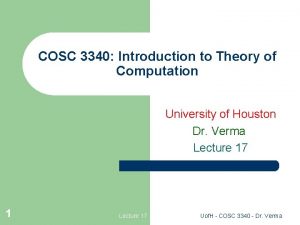COSC 3340 Introduction to Theory of Computation University



















- Slides: 19

COSC 3340: Introduction to Theory of Computation University of Houston Dr. Verma Lecture 4 1 Lecture 4 Uof. H - COSC 3340 - Dr. Verma

Formal definition of NFA acceptance l Define *(q, w) as a set of states: p ε *(q, w) if there is a directed path from q to p labeled w – l *(q 0, 1) = ? – l Ans: {q 0, q 1} *(q 0, 11) = ? – 2 Example: consider NFA of Lecture 3 Ans: {q 0, q 1, q 2} Lecture 4 Uof. H - COSC 3340 - Dr. Verma

NFA acceptance (contd. ) 3 l w is accepted by NFA M iff *(q 0, w) F is nonempty. l L(M) = {w in * | w is accepted by M}. Lecture 4 Uof. H - COSC 3340 - Dr. Verma

NFA vs. DFA l Is NFA more powerful than DFA? – l Theorem: – l For every NFA M there is an equivalent DFA M' Proof Idea: – – l Ans: No. NFA is in a set of states at any point during reading a string. DFA will use a lot of states to keep track of this. Important Assumption: – No transition labeled by epsilon. (Will get rid of this assumption later. ) 4 Lecture 4 Uof. H - COSC 3340 - Dr. Verma

Equivalent DFA construction. l l NFA M = (Q, , , s, F) DFA M' = (Q', , , s', F') where: – – Q' = 2 Q s' = {s} F' = {P | P F is nonempty} ({p 1, p 2, pm}, ) = *(p 1, ) *(p 2, ) . . . *(pm, ) i. e. find all the states that can be reached on from all the NFA states in a DFA state. 5 Lecture 4 Uof. H - COSC 3340 - Dr. Verma

Example: Equivalent DFA construction NFA 6 Lecture 4 Uof. H - COSC 3340 - Dr. Verma

Equivalent DFA construction (contd. ) 7 Lecture 4 Uof. H - COSC 3340 - Dr. Verma

How to handle epsilon transitions? l Define e-closure of state q as *(q, ). – l 8 notation: e-closure(q). Example: Lecture 4 Uof. H - COSC 3340 - Dr. Verma

Handling epsilon transitions (contd. ) l Extend e-closure to sets of states by: – e-closure({s 1, . . . , sm}) = e-closure(s 1) . . . e-closure(sm) Now let s' = e-closure({s}). and, ({p 1, . . . , pm}, ) = e-closure( *(p 1, )) . . . e-closure( *(pm, )) to complete construction of DFA. 9 Lecture 4 Uof. H - COSC 3340 - Dr. Verma

Example: Handling epsilon transitions. 10 Lecture 4 Uof. H - COSC 3340 - Dr. Verma

DFA = ? 11 Lecture 4 Uof. H - COSC 3340 - Dr. Verma

Language Operations 1. Concatenation. Notation: L L' or just LL' – 2. Kleene Star. Notation: L* – L* = { w in * | w = w 1. . . wk for some k >= 0 and each wi in L}. l Examples: if L = {a(2 n+1) | n >= 0}. L' = {b(2 n) | n > = 0}. l LL' = ? – Ans: LL' = {a(2 n+1) b(2 m) | n, m > = 0} L* = ? – Ans: {an | n >= 0} U, . , * are called regular operations. l l 12 L L' = {uv | u in L, v in L'}. Lecture 4 Uof. H - COSC 3340 - Dr. Verma

Closure properties of regular languages. l l Previously we saw closure under and . New: Regular languages are closed under – – – 13 Concatenation Kleene star Complement. Lecture 4 Uof. H - COSC 3340 - Dr. Verma

Examples L = {w in {a, b}* | w has even a’s } 14 Lecture 4 Uof. H - COSC 3340 - Dr. Verma

Examples L' = {w in {a, b}* | w has at least one b} 15 Lecture 4 Uof. H - COSC 3340 - Dr. Verma

Construction for L L' 16 L’’ = (K, , , s, F) K = K 1 K 2 s = s 1 F = F 2 = 1 2 F 1 X {e} X {s 2} Lecture 4 Uof. H - COSC 3340 - Dr. Verma

L* and L'* L* M = (K, , , s, F) K = {s} K 1 F = {s} F 1 = 1 F 1 X {e} X {s 1} {(s, e, s 1)} Given M 1 = (K 1, , 1, s 1, F 1) L’* 17 Lecture 4 Uof. H - COSC 3340 - Dr. Verma

Complement of L and L' Complement of L’ 18 Lecture 4 Uof. H - COSC 3340 - Dr. Verma

General Construction for Complement DFA M = (K, , δ, s, F) K = K 1 s = s 1 F = K - F 1 δ = δ 1 L(M) = Complement of L(M 1) DFA M 1 = (K 1, , δ 1, s 1, F 1) Exercise: Will this construction work for NFAs? Explain your answer. 19 Lecture 4 Uof. H - COSC 3340 - Dr. Verma
 Cosc 3340
Cosc 3340 Cosc 3340
Cosc 3340 Cosc 3340
Cosc 3340 Cosc 3340
Cosc 3340 Sipser, m: introduction to the theory of computation
Sipser, m: introduction to the theory of computation Kine 3340
Kine 3340 O que hd
O que hd Ece 3340
Ece 3340 Kine 3340
Kine 3340 Common lisp: a gentle introduction to symbolic computation
Common lisp: a gentle introduction to symbolic computation Theory of computation
Theory of computation Transition graph in theory of computation
Transition graph in theory of computation Types of languages in theory of computation
Types of languages in theory of computation Theory of computation
Theory of computation Ambiguity
Ambiguity Finite automata calculator
Finite automata calculator Diagonalization method in theory of computation
Diagonalization method in theory of computation Anbncn pda
Anbncn pda Theory of computation quiz
Theory of computation quiz Computation
Computation
